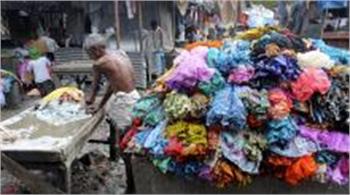 |
In Mumbai, it's dhobis against developers
 |
Globe and Mail- Nowhere is that more evident than here at Dhobi Ghat, a sprawling open-air compound under Mumbai’s Mahalaxmi bridge where the city’s dirty laundry comes to be washed, dried, ironed, starched, and returned. All in a day’s work, and not a single sock goes missing.
Each morning, some 10,000 dhobis or washermen rise with the sun to collect laundry from the southernmost tip of Mumbai to its northernmost suburbs and bring it here. The dhobis work for 14 to 16 hours to wash 100 to 200 articles of clothing each day. The dull thud of laundry slapping against the cement washboards can be heard every day of the year, with the exception of the Hindu festival Holi.
From dawn to dusk, almost all 826 of the original takils (cement stalls) are occupied by cleaners in various stages of undress in the stifling heat. Many of the dhobis work in a wash-dry tag team of father and son, earning 500 to 1,000 rupees ($10 to $20) from each stall on an average workday. These men, aged 14 to 65, and a handful of women, collectively handle more than a million articles of clothing a day. Their clients include the well-do-do as well as hospitals, hotels and the Indian Railways. “This is a dhobi community. We share the good, the bad, the wet, the dry,” says Sujil Kumar, 28.
Together with kolis (Mumbai’s fishermen caste), dhobis are among the oldest occupations in India. But in recent years, this bulwark of tradition has come under siege by an unlikely modernizing force: the Brihanmumbai Municipal Corp., the city government. The BMC and the Dhobi Co-op Society, a de facto labour union for the dhobis, have been embroiled in a legal dispute that pits the washermen against demands from developers.
The source of the conflict is simple: This patch of land in the heart of Mumbai where the dhobis ply their trade is only 40,000 square feet, about the size of two Shoppers Drug Mart stores – yet it’s worth a staggering 10 billion rupees ($220-million) and is perhaps the last meaningful chance at large-scale development in Mumbai’s land-starved high-density financial district.
This looming battle between tradition and profit in the heart of Mumbai is one of many such being fought in India, where the corporate titans of Tata Motors Ltd. and Infosys Ltd. clash with a way of doing business in which bribes are routine and many executives still consult astrologers.
India has enabled the successes of corporate giants such as Reliance Industries Ltd. and Wipro Ltd. It is reputed to be home to the largest number of billionaires in Asia. But India is also a nation still bound by the caste order and crippled by poverty, where the government estimates 93 per cent of its business is conducted under the table.
It’s a city of dichotomies. Along the seawall of this island city, women in burkas pass others wearing spandex and running shoes, and ashram gurus can be seen playing Angry Birds on their iPhones. In Mumbai, institutions such as Dhobi Ghat exist alongside bustling railway tracks and looming skyscrapers.
This division is especially evident in the Mumbai tower known as The Imperial, the world’s tallest residential building, where the first 20 floors are given over to former slum dwellers (thus meeting the municipal code) and from the 21st floor onward, well-to-do industrialists, foreign expatriates and Bollywood stars live in luxury condos.
The city’s current property bubble can be traced back to 2005 when the government opened up the real estate market to foreign direct investment. Today, land in Mumbai is worth more than land in Manhattan.
Mumbai’s developers believe that it is only a matter of time until the BMC gives in to the demands of the commercial real estate lobby and forces the dhobis to sell their land.
455 page views
|
|
|
|